THE CULTURE OF TAPIOCA
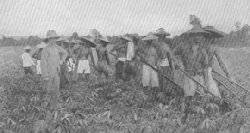 | Tapioca plantation.
Malayan, Peru. |
Tapioca is probably a native of Brazil, but is also largely cultivated in Peru, Guiana, Venezuela, the West Indies, South India and Malaysia. The bitter kind, which is more productive than the sweet species, is propagated by cuttings from the ligneous part of the stem, planted in rich, dry soil. The tubers are ready for digging up in from six to twelve months, according to the variety.
There are two modes of preparing the starch. In the wet method the grated root is placed in water for about five days, then kneaded with water, and pressed to extract the juice. The fecula is sifted and baked in earthen ovens, some fresh manioc paste, which has fermented being always added. In the dry process the root is rasped by hand, and, after adding water, is pressed; after drying and sifting it is baked. The fecula deposit is washed three times and sun-dried. The collected starch, heated on iron plates, becomes partially cooked and agglomerates in small, hard, irregular lumps, constituting tapioca.
The culture of tapioca is inexpensive and the product is highly remunerative, so that the growth of the plant is becoming very general throughout the tropics.
COTTON CULTURE
COUNTRIES SMITTEN BY THE GREAT FAMINES OF HISTORY
Table of Contents
Return to Main Page
© 1998, 2002 by Lynn Waterman
COTTON CULTURE
Herodotus, surnamed the Father of History, who was born B. C. 484, traveled through Europe, Asia and Africa, and when in India, saw and described the cotton plant. He says: "The wild trees in that country bear for their fruit fleeces surpassing those of sheep in beauty and excellence, and the natives clothe themselves in cloths made therefrom."
SELF PERPETUATED IN ANCIENT TIMES.
In those ancient times the cotton plant perpetuated its own species through the dispersion of its seeds by the winds. The root of the plant is top-shaped, and penetrates very deeply into the earth.
VARIETIES OF COTTON IN AMERICA.
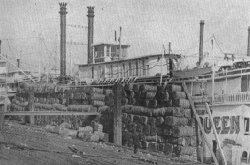 | | Loading cotton, New Orleans. |
In America are no less than 130 varieties of cotton. Among the chief commercial types is the "Gossypium Barbadense," which is indigenous to the Lesser Antilles, and is extensively cultivated in the United States, as well as in the West India Islands, Central America, Western Africa, Bourbon, Egypt, Australia and the East Indies.
BRAZILIAN COTTON.
Another variety of cotton is cultivated very extensively in the coast region of Brazil. Just after the Civil War the cotton export from Brazil was over 100,000,000 pounds per year. It afterwards fell to 50,000,000.
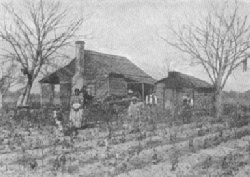 | | Portion of large southern cotton plantation. |
Pernambuco, Parahyba and Alagoas are the chief producers of cotton in Brazil, although its culture extends as far south as Rio Grande do Sul. It requires little labor in that region, and a very limited capital is sufficient.
The height of the species common to the United States varies from three to four feet, if cultivated as an annual, and from six to eight feet, if allowed to grow as a perennial. When in full leaf and flower, it is a most graceful looking plant. Yarns having the finest counts, as they are called, are all spun from Sea Islands, which belongs to this class.
A THREAD 160 MILES LONG.
A single pound of this cotton is often spun in a thread 160 miles long.
In the United States cotton is cultivated in North Carolina, South Carolina, Georgia, Florida, Arkansas, Tennessee, Alabama, Mississippi, Louisiana and Texas.
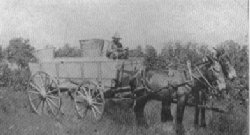 | | Hauling cotton to the gin. |
In the beginning of the 19th century South Carolina produced more cotton than any other state. Fifty years later, Alabama went to the front. Ten years later, Mississippi led, and in 1890, Texas was first, with 1,471,242 bales.
COTTON PICKING.
Late in July, or early in August, the cotton pods begin to show a few ripe open bolls, and the sacks and baskets are made ready for picking. Picking cotton must be done under a shining sun, and is very wearisome work. After being picked it must be carried to the gin house before the night dews touch it.
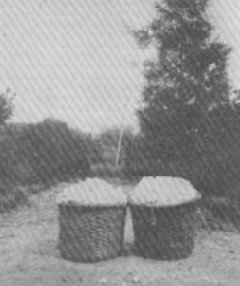 | | Bales of cotton as it is picked. |
At present most of the cotton produced in the world is ginned by machinery. Ginning consists in separating the cotton from the seeds. From 66 to 75 pounds of seeds are got from every 100 pounds of seed cotton. After this process, it is gathered into bundles and roughly baled. Then it goes to the "compressors," where it undergoes, under enormous pressure, great reduction in bulk. After this, it is subjected to several important processes before being ready for commercial use.
GREAT VALUE IN COTTON SEED.
In no direction have modern processes for the utilization of so-called waste material produced larger or more gratifying results than in the conversion of cotton seed into a valuable commodity.
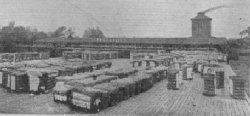 | | Cotton compress at Birmingham, Alabama. |
Forty years ago there was no use for cotton seed, the decaying accumulations of which were a menace to the health of Southern communities. In 1900, when 53 per cent of the seed produced was utilized, the planters received $28,632,000 for seed sold to the oil mills, and the value of the products of those mills was $41,411,000. Half(46,902,000 gallons) of the oil made in that year was exported. To invest an article with a value of millions of dollars which, 40 years ago, was deemed worthless, is certainly an achievement worthy of a place among the miracles of modern times.
BOOK IV
THE CULTURE OF TAPIOCA
Table of Contents
Return to Main Page
© 1998, 2002 by Lynn Waterman
|





